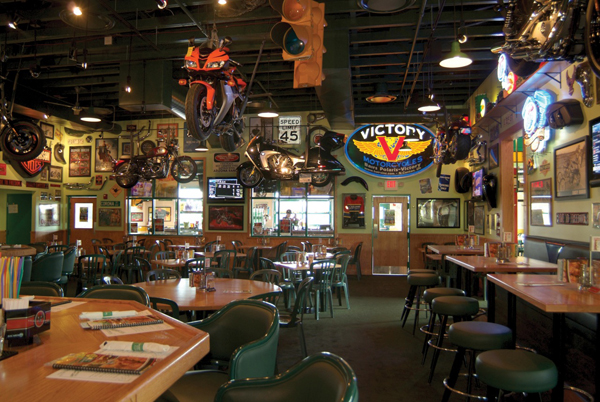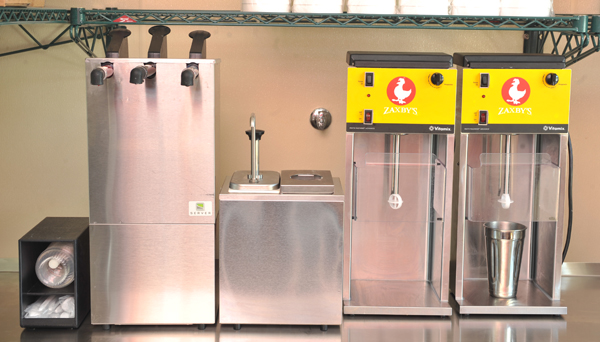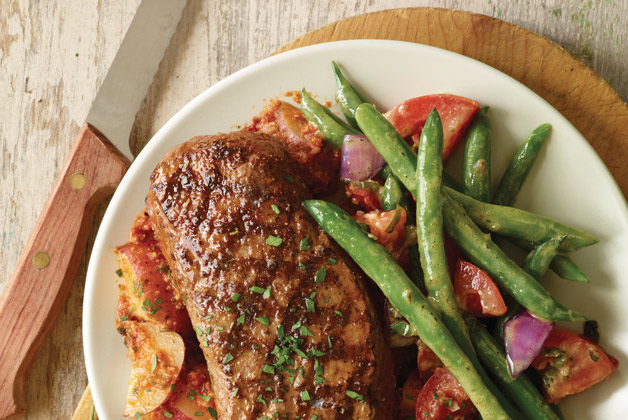Menu Innovation vs. Design Limitations
Staying fresh and new — that's the challenge chains face on an ongoing basis. It seems like every week or month, at least, chains like McDonald's, Taco Bell, Chick-fil-A and the like roll out new foods and flavors. Menu innovation plays an important part in the ongoing quest for relevancy, but how do you roll out new items without damaging flow? How do you build in flexibility with efficient kitchen design and equipment selection to accommodate new developments?
"It's almost like a symphony, where you have different parts of the orchestra playing in perfect harmony," says Jay Johns, vice president of strategy implementation for DineEquity's IHOP and Applebee's restaurants. "The chef or culinary director has to develop great new menu items, but they need to be cross-functional with all the different departments in the company, from operations to marketing, to ensure everything is in balance."
Juan Martinez, principal of Profitality, a Miami-based hospitality design consultancy, agrees with this strategy. "I once heard an executive from Outback say, 'If you don't innovate your menu, your brand will die, but if you innovate your menu wrong, you can kill your brand.' " Dramatics aside, menu innovation is vitally important to maintaining a competitive advantage, one that requires a well-thought-out, heavily tested and planned approach — one that won't damage a core brand, says Martinez. "I call it 'efficient menu innovation,'" he says.
Menuing
Efficient menu innovation begins with heavy consumer surveying of core menu items as well as special promotions incorporating seasonal foods, regional-focused dishes and limited time offers (LTOs). The frequency of new rollouts differs from brand to brand; IHOP and Applebee's change their core menus every few years, introducing multiple seasonal items and LTOs throughout the year, according to Johns. In fact, "change is status quo for our stores — our operators expect it, so we need a military-like operation to make sure we're communicating and training our people," he says.

Quaker Steak & Lube offers three LTO programs annually, usually featuring three to five new items for a testing process lasting three to four months. "Our LTO schedule is a vehicle to test items prior to putting them on our menu," says Kate Malanik, senior director of food and beverage. While marketing and new product introductions drive menu innovation, lackluster sales for certain items can also spur the need for change.
At Zaxby's, systems development manager Matt Anderson says each quarter brings with it a new promotional item. "We maintain a regular testing process, so we always have a few LTOs in our pocket in case sales are stagnant for certain items," he says. "Low performers are always on the chopping block."
Testing
Testing before rollout is critical when it comes to menu innovation. For most quick-serve brands and high-volume chains, speed of service and quality represent the two most important factors.
"When it comes to menu innovation, what's important to most chains is that new items fit into their production cycle," Martinez says. With burgers, for example, introducing a new variation can be as easy as swapping out one sauce for another or one cheese for another. "From an employee standpoint it's easier because you still have the same burger production cycle."
Larger changes require much more testing. "You have to predict how much of the new product you might sell and then see how long it takes to produce those items at high volumes," Martinez says. With many quick-serves switching to more of a cooked-to-order process, this type of testing becomes even more important. "There is a direct relationship between assembly time and customer service."
Johns, an operator by trade, says he's constantly looking for feedback from the stores in terms of how the new items are impacting not only sales, but also operation and flow. "Speed of service and quality are critical," he says. "We want to be able to replicate the same quality from the test kitchen in the field where volume and speed come into play. This is why we don't have soufflés on our menu, for example."
Del Taco shares the same focus when it comes to new menu rollouts. "Our biggest challenge is speed of service," says Mike Salem, senior director of research and development. "I want new menu items to be able to work in the existing footprint before considering new equipment or design."
With more than 500 stores, Salem focuses on the "least common denominator," making sure new items work across the system. In fact, Salem subscribes to a "fail forward fast" methodology. "I'm looking at every way possible to potentially fail the concept through extensive time and motion studies," he says.
When new products fail to meet speed of service, throughput and quality levels during testing, Salem, Malanik and Johns will look to tweak the menu item before considering any equipment or operational changes. While Malanik works with vendors to find new solutions, such as purchasing pre-breaded chicken breasts or hard-cooked eggs, Johns focuses on recipe engineering to fit the new product into current operations.
For example, a thick-cut steak might not cook as fast in the restaurant as in the test kitchen, so Johns will work with the culinary team to consider a thinner product of the same weight. He might also shift the product from one piece of equipment to another. "Maybe the chef wanted to cook the steak on the flattop, but it doesn't get hot enough and recover fast enough so we'll move it to the charbroiler instead," says Johns.
Equipment
With capital tight and the need to show quick return on investments, many chains look to leverage what equipment they have rather than invest in new pieces. At the same time, they don't want to dampen or limit culinary innovation.
"Our culinary team doesn't work in a vacuum," says Johns. "We don't put handcuffs on culinary and tell them not to develop something because we don't have the equipment." Instead, culinary, operations and design specialists work together to develop new processes around existing equipment and layout.
Johns also strives to balance the menu across multiple cooking platforms to prevent overstressing any one piece of equipment. "You can't roll out all menu items made on the charbroiler at once," he says. "If one station is overwhelmed because of a promotion, we look at ways to relieve that by deleting other items made on the same station off the menu."
When equipment investments do happen, just like a new sauce or product purchase, that piece needs to be able to prepare a variety of menu items, says Martinez. Chains tasked with justifying equipment purchases must show a return on investment.
For Del Taco's Salem that means "right-sizing" the equipment and the surrounding design to maximize efficiencies and save space. "We like to create as many uses for the equipment as possible."
For Anderson at Zaxby's, this strategy means investing in flexible pieces. While the ubiquitous flattop is known for its versatility, Zaxby's relies on its clamshell griddles for multiple menu items, even using the piece as a panini press. The chain has also switched from low-proximity hoods to a canopy setup to regain flexibility in case equipment pieces are moved around or added. All new stores in the 575-unit chain feature larger hoods designed to support new equipment additions. To save energy, all hoods come equipped with demand-controlled variable-speed technology.
Zaxby's has worked to build flexibility into the design of the kitchens as well. "We eliminated all the walls in the back of the house with the purpose of being able to rearrange equipment and processes in the future," Anderson says.
Implementation
When the justification and time is right to invest in new equipment for menu innovation, testing again becomes imperative.
 Zaxby's Premium ShakesZaxby's Premium ShakesWhen Zaxby's decided to introduce milkshakes a few years ago, the chain started with a test market of about 20 locations for a span of 6 months. To install the milkshake system, Anderson had to not only find extra room in the drive-thru area, already tight on space, he also had to account for extra space in the freezer for new product. The compact drive-thru space already included a 21-inch table for meal assembly, a soda dispenser, and tea and coffee urns.
Zaxby's Premium ShakesZaxby's Premium ShakesWhen Zaxby's decided to introduce milkshakes a few years ago, the chain started with a test market of about 20 locations for a span of 6 months. To install the milkshake system, Anderson had to not only find extra room in the drive-thru area, already tight on space, he also had to account for extra space in the freezer for new product. The compact drive-thru space already included a 21-inch table for meal assembly, a soda dispenser, and tea and coffee urns.
"We originally tested frozen custard, but the machine was so enormous and complicated to operate that we couldn't go that route," Anderson says. To save space in drive-thru, the design team swapped out the bigger table for a smaller, multiuse stainless steel version and, in some cases, relocated ice machines.
"Once the milkshake test was in place and we knew it was going to be successful, we went back to the drawing board in the field, creating space for the station in new-build stores," he says. The team selected a particular stainless steel table with enough room underneath to house an additional, small milkshake freezer to prevent taking up more space in the main walk-in and making it easier for staff to access what they need. Anderson and designers also worked to open up the space to create more flow between the milkshake, drive-thru and main order counters.
The introduction of the new equipment also led to extra electrical requirements, a consideration Martinez says is essential for new equipment implementation.
At Quaker Steak, Malanik's team went through similar design and implementation challenges with a new line of flatbreads a couple years ago. "Several of our older locations didn't have the conveyor broilers, which they had to purchase to be able to do the flatbreads," she says. Before that happened, the chain heavily tested the menu item to ensure a return on investment. The conveyor model proved to be more flexible and ensured greater consistency and quality than the previously used salamanders. "With the conveyor, you can just drop it and forget it, whereas with the salamander, you had to watch the food to make sure it didn't burn."
Quaker Steak also experimented with beer battering for a fish-fry item in the Wisconsin market. "It was a challenge putting together that program because you need to introduce batter stations, extra refrigeration, and ask your franchisees to dedicate one of their fryers to the fish," Malanik says. Projected sales had to outshine equipment investment, and in that case the project was a go.
 Zaxby's equipment
Zaxby's equipment
Close communication with franchisees is crucial in such cases. Not only do you have to sell new menu items to the public, you have to sell franchisees on the new items too, says Malanik. Twenty percent of Quaker Steak's more than 50 restaurants are franchise-operated.
"We involve our franchisees heavily in the testing program and always work to get their feedback throughout the whole process so they can become advocates for the new items and help us sell the new items to the rest of the company," Malanik says. "My team needs to act like a liaison between the company and franchisees. We want to make sure the restaurant can execute the menu in a high-volume setting and prevent mistakes that will affect guest satisfaction."
Part of that structure includes writing new menu items and processes into training plans and standard operating manuals, including food safety and HAACP programs. In the case of Quaker Steak, that means writing into the training manual the steps needed to batter the fish and specifying that a separate fryer must be used to cook it.
Analysis
Analyzing sales for new menu items once thoroughly tested, vetted and practiced is the last, albeit ongoing, step in the process. Malanik says Quaker Steak tracks new menu sales on a weekly basis, at least.
In addition to tracking sales, Salem strives to track the "return on guest" for new menu items similar to return on investment for new equipment. Del Taco conducts this type of analysis through regular customer surveys regarding the quality, freshness, temperature, delivery and, of course, taste of the new menu items.
"You can't always articulate the return on guest through a traditional P&L," he says. Instead, repeat sales of that one menu item and repeat business overall as well as positive attitude and usage surveys determine this qualitative data.
Calculating labor costs for new menu items poses greater challenges. "It's pretty easy to calculate food cost, but it can be challenging to calculate labor cost," says Martinez. "The common assumption is if I'm running 18 percent today, it will be the same for the new menu item. Maybe that's the case, but maybe not. You need to factor in prep time, equipment setup and cleanup, thinking more holistically about the process."
Martinez calls this particular thought process a work- and activity-based labor analysis. "It doesn't matter if I sell a new burger for $5 or 5 cents — what matters is how long it takes me to produce it and with how much effort," he says. "The more labor I have, the faster I can react. Less labor means less time for reaction. Labor deployment is important for delivering the new menu items at the desired service and quality levels."
As Martinez stresses, menu innovation remains the key to ongoing brand development, relevancy and a sense of newness or freshness. Innovation means attracting new customers while keeping the regulars happy with new tastes. Still, it's not as easy as 1-2-3. A rigid, structured, and thorough testing and implementation process ensures that LTO can successfully become part of the menu's core.




